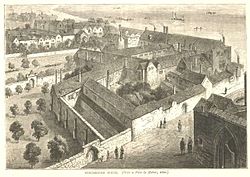Winchester Palace
| Winchester Palace | |
|
Surrey | |
|---|---|
 Remains of the great hall of Winchester Palace | |
| Location | |
| Location: | 51°30’25"N, 0°5’27"W |
| Town: | Southwark |
| History | |
| Built 12th century | |
| Information | |
| Owned by: | English Heritage |
| Website: | Winchester Palace |
Winchester Palace was a twelfth-century palace in Southwark in Surrey, which served as the townhouse of the Bishops of Winchester close to London.[1][2]
The palace now stands in ruin, on the south bank of the River Thames, near the mediæval priory which later became Southwark Cathedral. Remains of the demolished palace survive on the site today.
History

Southwark was formerly the largest manor in the Diocese of Winchester, which encompassed Hampshire and Surrey, and the Bishop of Winchester was a major landowner in the area. He was a great power in the land, and traditionally served as the king's royal treasurer. He thus frequently needed to attend the king both at his court in Westminster, at the Tower of London and also was required to attend Parliament with other bishops and major abbots. Henry of Blois built the palace as his comfortable and high-status residence close to London. Most of the other bishops similarly had episcopal palaces in or near London, most notably Lambeth Palace, also in Surrey, residence to this day of the Archbishop of Canterbury.
The palace remained in use until the 17th century, when it was divided into tenements and warehouses, but was mostly destroyed by fire in 1814. Part of the great hall, and the west gable end with its rose window became more visible after a 19th-century fire and 20th-century redevelopment. It is believed that the great hall was built in about 1136.
The hall was enlarged and the rose window built in the 14th century, possibly by Bishop William of Wykeham (bishop 1367–1398).[3]
Below the hall was a richly decorated vaulted cellar with direct access to a wharf on the River Thames for bringing in supplies. Royal visitors were entertained at the palace, including King James I of Scotland on his wedding to Joan Beaufort (niece of the then bishop, Cardinal Henry Beaufort) in 1424. The palace was arranged around two courtyards. Other buildings within the site included a prison, brewery and a butchery. The palace environs comprised a garden, a tennis court and a bowling alley.
During the Civil War, Sir Thomas Ogle was imprisoned here, during which time he tried to draw Thomas Devenish, a member of John Goodwin's Independent Congregation, into a royalist plot to split the Parliamentarian Independents from the Presbyterians in order to help the royalist capture the City of London.[4]
The Clink Liberty
Associated with the palace was the Liberty of the Clink which also lay on the south bank of the River Thames, an area free from the jurisdiction of the City of London. It therefore became an area where activities which were suppressed in the City could flourish openly. Thus gaming houses, bowling alleys, theatres and brothels abounded.[5] It took its name from the notorious Clink prison which lay within the Liberty and gave rise to the slang expression "in the clink" (meaning 'in prison').[6] The Bishops of Winchester received rents from the numerous brothels, leading to the local prostitutes being known as "Winchester geese".[7]
Present day
The remains of Winchester Palace are listed as a Scheduled Monument and are managed by English Heritage.
Outside links
| ("Wikimedia Commons" has material about Winchester Palace) |
- Archaeology of Winchester Palace
- Winchester Palace – English Heritage
References
- ↑ Winchester Palace
- ↑ Survey of London: volume 22: Bankside (the parishes of St. Saviour and Christchurch Southwark), Sir Howard Roberts and Walter H. Godfrey
- ↑ Survey of London: volume 22: Bankside (the parishes of St. Saviour and Christchurch Southwark)
- ↑ John Coffey (2006), John Goodwin and the Puritan Revolution, Woodbridge: Boydell Press, 1843832658, ISBN 1843832658, http://openlibrary.org/books/OL22748134M/John_Goodwin_and_the_Puritan_Revolution
- ↑ Jeffrey L. Forgeng, Daily life in Stuart England. Greenwood Press, 2007. ISBN 978-0-313-32450-5 (p. 142)
- ↑ Christopher Hibbert Ben Weinreb, John & Julia Keay, The London Encyclopaedia 3rd Edition, Macmillan, London 2008 ISBN 978-1-4050-4925-2 (p. 196)
- ↑ Russell A. Fraser, Shakespeare: a Life in Art, Transaction Publishers, New Brunswick NJ, 2008. ISBN 978-1-4128-0605-3 (p. 108)